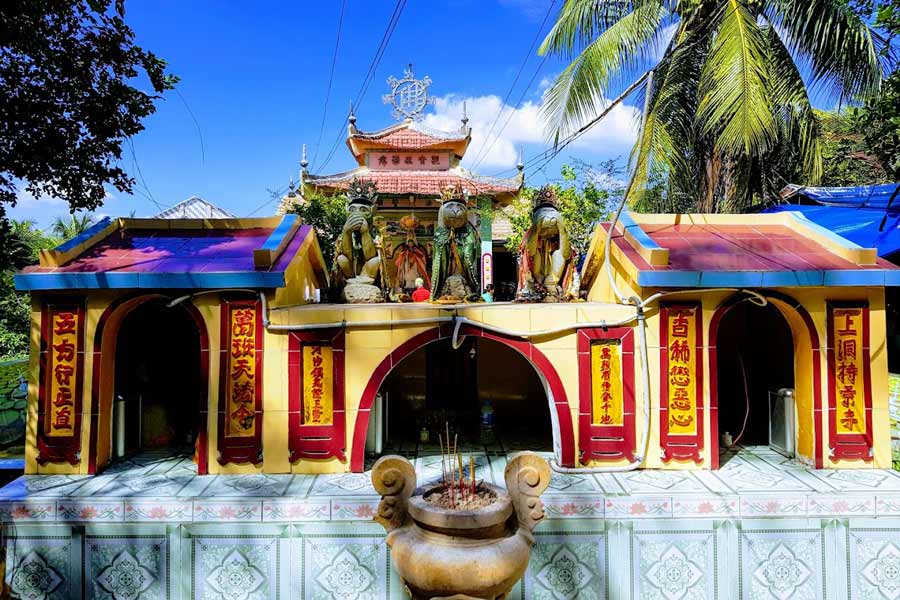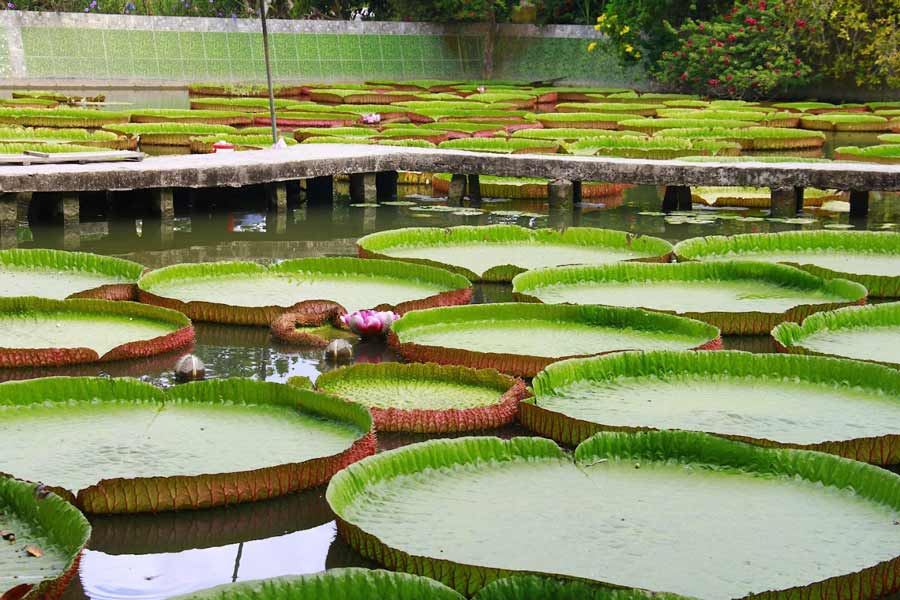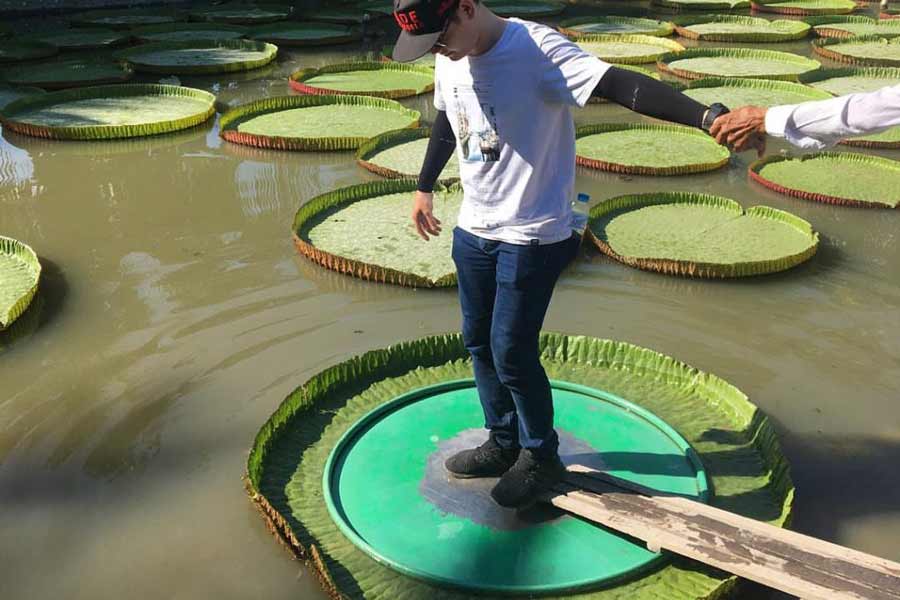Phuoc Kien Pagoda

The Lotus Leaf Pagoda, also recognized as Phuoc Kien Tu Pagoda, stands as a distinctive and ancient architectural gem within Dong Thap province. In recent times, La Sen Pagoda has emerged as a compelling attraction for numerous tourists exploring this region. Devotees are drawn to the pagoda owing to its exceptional lotus pond, which distinguishes itself from the conventional perception of lotus flowers characterized by their noble, delicate, and fragile beauty. What sets the lotus flowers of Phuoc Kien Pagoda in Dong Thap apart is their remarkable size, capable of supporting the weight of individuals without significantly disrupting the water surface.
The Lotus Leaf Pagoda, also known as Phuoc Kien Pagoda, was established over 150 years ago, predating the reign of King Thieu Tri of the Nguyen Dynasty (1841). Since its initial construction, the temple has occupied a vast, airy, and remarkably majestic campus. Throughout its history, Phuoc Kien Pagoda served as a clandestine hub for revolutionary activities during times of war. Regrettably, in 1966, the pagoda suffered complete destruction due to wartime bombings. Subsequently, from 1975 onward, efforts were made to reconstruct the pagoda with a simpler design, including an entrance gate, a worship tower dedicated to Guanyin Buddha, and the main hall area.
Despite enduring the challenges of wars and conflicts, the pagoda, now adorned with unique giant lotus leaves in the lake at its center, has transformed into both a religious edifice and a renowned tourist attraction in Dong Thap. These colossal lotus plants were planted in 1992; however, six years later, during the summer, the lake dried up, causing the lotus to wither. It wasn't until the flooding season that same year that the lotus flourished once more, displaying the vibrant greenery seen today. Additionally, the ancient temple harbors numerous captivating spiritual tales, including those involving turtle and crane statues, along with other distinctive elements awaiting discovery by visitors.
Phuoc Kien Pagoda captivates visitors with enchanting tales of magical turtles and cranes. According to local accounts, in 1948, a turtle was presented as a gift to the pagoda. This extraordinary turtle, known for spending entire days near the monk, immersed itself in the rhythmic chanting of Buddha. Even amidst the devastating impacts of the war in 1966, which left the pagoda in ruins, the turtle was captured but managed to find its way back to the pagoda independently.

Hundred year old turtle
In 1999, the temple witnessed the arrival of a crane, a mystical companion that frequently perched on the turtle's back. Strangely, when the crane eventually departed, the turtle also passed away. In a gesture of reverence, the abbot preserved the turtle's body, adorning it with a rosary. The turtle's remains were then placed in a glass cage within the temple, serving as a poignant and symbolic testament to the enduring connection between these two magical creatures. This captivating narrative adds an extra layer of allure to the spiritual and historical significance of Phuoc Kien Pagoda.
Visit and worship Buddha at the temple

Three meaningful statues 'Do not say evil words - Do not listen to evil words - Do not see evil things'
Phuoc Kien Pagoda, despite its modest size, boasts a rich history that spans over a century. According to legend, the pagoda predates the reign of King Thieu Tri, who ascended the throne in 1841, making it a significant site for expressing the traditional beliefs of the local community. Beyond its historical importance, Phuoc Kien Pagoda is intertwined with mysterious and unique legends that add to its allure. These captivating stories contribute to the pagoda's reputation, drawing thousands of visitors each year who come to burn incense and engage in prayers.
Admire the giant lotus

Lotus leaves have a diameter of 1.5m or more
The unique lotus known as the "king lotus," also referred to as the silkworm lotus or water lily, is a rare plant indigenous to South America, specifically the Amazon region. Each fully mature lotus leaf boasts an impressive diameter ranging from 2 to 2.5 meters, although it tends to narrow down to about 1.5 meters during the summer months. Notably, the edges of these lotus leaves have a characteristic upward curvature of up to 2 centimeters. One remarkable feature of the king lotus is its exceptional strength, capable of supporting individuals weighing up to 140 kilograms.
Enjoy experience standing on lotus leaves

Tourists visiting the pagoda experience standing on lotus leaves
Visiting the historic Phuoc Kien Pagoda offers a unique opportunity for an extraordinary experience – standing on a giant lotus leaf. To ensure the delicate nature of the leaf is preserved during this unforgettable moment, visitors typically take a precautionary measure. Before standing on the leaf, a thin aluminum sheet is carefully placed inside, ensuring that the leaf remains intact and undamaged when weight is applied.
Hundred-year-old turtles

Three hundred-year-old turtles in Phuoc Kien pagoda
In addition to the lotus with giant leaves, Phuoc Kien Tu Pagoda also owns many other "treasures", including 3 turtles. Among these three turtles, one is 106 years old (weighs 15kg), one is 101 years old (weighs 13kg), and are called "old turtles". One special thing is that the youngest turtle only sleeps under a mosquito net and never goes into the water
Sightseeing tickets to La Sen Pagoda are complimentary, allowing visitors to explore the cultural and historical marvels of this ancient site without a charge. However, for a unique experience of sitting on a lotus leaf and capturing memorable photographs, a nearby household offers specialized services. The pagoda provides a wooden board for visitors to step onto the lotus leaf comfortably. The service fee for this distinctive experience is 20,000 VND per person, offering an affordable and enchanting addition to your visit to La Sen Pagoda.
The optimal period to explore Phuoc Kien Pagoda is typically during September and October annually, coinciding with the peak of the flood season in the Western region when the lotus leaves reach their maximum size. This timeframe offers a convenient opportunity for a river region excursion coupled with visits to pagodas for prayers and sightseeing. It is advisable to plan your visit around 10 am, as this is when the lotus blooms are most enchanting throughout the day. During this period, the colors and lighting conditions are particularly captivating, especially on sunny days, enhancing the overall visual experience and making it an ideal time for capturing beautiful photographs.
If you commence your journey from Saigon, head northwest towards Phan Van Hon, then proceed along the Dai Han Highway leading to the Ho Chi Minh City Expressway. After traveling approximately 40 km, you will reach a roundabout; take the first exit onto National Highway 1A. Continue along National Highway 1A for another 57 km until you reach Sa Dec.
From Sa Dec Flower Village to My Thuan Bridge via Highway 80, once you pass Nha Man bridge, drive 50m and make a right turn onto TL 854. Travel for about 11km, and you'll come across the parking area to access La Sen Pagoda. People have placed parking signs along both sides of the road, eliminating concerns about overshooting.
In close proximity to the parking area, there's a T-shaped bridge spanning the river. Upon descending from the bridge, turn left and proceed around 200 meters to spot the pagoda on the right. The temple grounds are spacious, providing ample space for you to conveniently park your car.